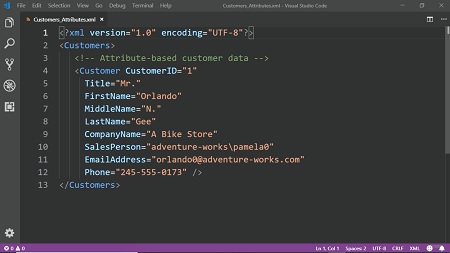
English | MP4 | AVC 1280×720 | AAC 44KHz 2ch | 1h 47m | 300 MB
Learn to use LINQ to XML and XPath queries to process XML files in C#. Use XML serialization to store .NET objects in an XML file and deserialize XML back into a .NET object. Learn to cache frequently used data in a local XML file.
What are the best methods for reading and writing XML documents in C#? In this course, XML Fundamentals in C#, you will gain foundational knowledge to process XML files and use XML to enhance your business applications. First, you will learn to process XML documents using LINQ to XML. Next, you will discover how to write XPath queries. Following that, you will see how to add, edit, and delete data within an XML document. XML serialization is explored to show you how to save a .NET object to an XML file, and then restore that XML as a .NET object. Finally, you will explore how to cache frequently used database data as a local XML file, and to detect when server data changes so you can update your local file. When you’re finished with this course, you will have the skills and knowledge of XML needed to process XML documents in C#. Software required: Visual Studio 2017, .NET 4.5+, SQL Server, C#.
Table of Contents
1 Course Overview
2 Course Introduction and Assumptions
3 Modules in This Course
4 Examples and Uses of XML Files
5 Terminology Used to Describe XML Documents
6 Tag Naming and Attribute-based XML
7 A Simple XML Schema File
8 A More Complex XML Schema
9 Generate an XSD File from an XML File
10 Validate an XML from an XSD File
11 Module Summary
12 LINQ to XML Introduction
13 Load XML Using XDocument and XElement
14 Query All Nodes in XML Document
15 Use a Where Clause to Filter XML Data
16 Use an OrderBy Clause to Sort XML Data
17 Joining Two XML Documents
18 Read Configuration File
19 Create Collection Classes from XML Document
20 Count and Sum Values
21 Maximum and Minimum Values
22 Calculate an Average Value
23 Module Summary
24 Introduction to XPath Queries
25 Using XDocument Class and XPath Queries
26 Using XElement Class and XPath Queries
27 Count, Sum, and Average Calculations
28 Minimum and Maximum Calculations
29 Module Summary
30 Module Introduction
31 Create New XML Document
32 Use the Parse Method to Load a String of XML
33 Add a Node
34 Update a Node
35 Delete a Node
36 Write XML to Disk Using the XDocument Class
37 Using the XmlWriter Class to Save XML to Disk
38 Using the DataSet Class to Save XML and XSD to Disk
39 Module Summary
40 Module Introduction
41 Using the XmlSerializer Class
42 Controlling Serialization with Attributes
43 Nested Objects and the XmlArray Attribute
44 Simplify Serialization with XML Extension Methods
45 Opt-In Serialization with the DataContractSerializer Class
46 Using the BinaryFormatter Class
47 Module Summary
48 Module Introduction
49 Get Data from Server and Store Locally
50 How to Detect Changes Between Server and Local XML
51 Demo – Detecting Changes
52 Demo – C# Code to Detect Changes
53 Summary and Location of Sample Code
Resolve the captcha to access the links!